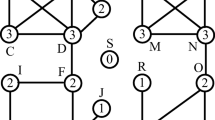Abstract
Most existing works on detection of social groups or communities in online social networks consider only the common topical interest of users as the basis for grouping. The temporal evolution of user activities and interests have not been thoroughly studied to identify their effects on the formation of groups. In this paper, we investigate the problem of discovering and tracking time-sensitive activity driven user groups in dynamic social networks. The users in these groups have the tendency to be temporally similar in terms of their activities on the topics of interest. To this end, we develop two baseline solutions to discover effective social groups. The first solution uses the network structure, whereas the second one uses the topics of common interest. We further propose an index-based method to incrementally track the evolution of groups with a lower computational cost. Our main idea is based on the observation that the degree of user activeness often degrades or upgrades widely over a period of time. The temporal tendency of user activities is modelled as the freshness of recent activities by tracking the social streams with a fading time window. We conduct extensive experiments on two real data sets to demonstrate the effectiveness and performance of the proposed methods. We also report some interesting observations on the temporal evolution of the discovered social groups.
Similar content being viewed by others
Notes
- 1.
- 2.
Big Brother 14 was the 14th season of the American reality television series.
- 3.
A tradition in which the users can recommend their followers to follow more people.
References
Natarajan, N., Sen, P., Chaoji, V.: Community detection in content-sharing social networks. In: ASONAM, pp. 82–89 (2013)
Qi, G., Aggarwal, C., Huang, T.: Community detection with edge content in social media networks. In: ICDE, pp. 534–545 (2012)
Newman, M.E.J., Park, J.: Why social networks are different from other types of networks. Phys. Rev. E 68, 036122 (2003)
Yang, T., Jin, R., Chi, Y., Zhu, S.: Combining link and content for community detection: a discriminative approach. In: KDD, pp. 927–936 (2009)
Greene, D., Doyle, D., Cunningham, P.: Tracking the evolution of communities in dynamic social networks. In: ASONAM, pp. 176–183 (2010)
Chen, Y., Kawadia, V., Urgaonkar, R.: Detecting overlapping temporal community structure in time-evolving networks. e-print: arXiv:1303.7226 (2013)
Kim, M., Han, J.: A particle-and-density based evolutionary clustering method for dynamic networks. In: VLDB, pp. 622–633 (2009)
Meo, P.D., Ferrara, E., Fiumara, G., Provetti, A.: Generalized Louvain method for community detection in large networks. In: ISDA, pp. 88–93 (2011)
Palla, G., Barabasi, A.L., Vicsek, T.: Quantifying social group evolution. Nature 446(7136), 664–667 (2007)
Cuzzocrea, A., Folino, F.: Community evolution detection in time-evolving information networks. In: EDBT, pp. 93–96 (2013)
Cohen, J.: Trusses: cohesive subgraphs for social network analysis. Technical report, National Security Agency (2008)
Fang, Y., Cheng, R., Luo, S., Hu, J.: Effective community search for large attributed graphs. In: VLDB, pp. 1233–1244 (2016)
Asur, S., Parthasarathy, S., Ucar, D.: An event-based framework for characterizing the evolutionary behavior of interaction graphs. In: KDD, pp. 913–921 (2007)
Bogdanov, P., Busch, M., Moehli, J., Singh, A.K., Szymanski, B.K.: The social media genome: modeling individual topic-specific behavior in social media. In: ASONAM, pp. 236–242 (2013)
Acknowledgment
This work is supported by the ARC Discovery Projects DP160102412 and DP140103499.
Author information
Authors and Affiliations
Corresponding author
Editor information
Editors and Affiliations
Rights and permissions
Copyright information
© 2017 Springer International Publishing AG
About this paper
Cite this paper
Anwar, M.M., Liu, C., Li, J., Anwar, T. (2017). Discovering and Tracking Active Online Social Groups. In: Bouguettaya, A., et al. Web Information Systems Engineering – WISE 2017. WISE 2017. Lecture Notes in Computer Science(), vol 10569. Springer, Cham. https://doi.org/10.1007/978-3-319-68783-4_5
Download citation
DOI: https://doi.org/10.1007/978-3-319-68783-4_5
Published:
Publisher Name: Springer, Cham
Print ISBN: 978-3-319-68782-7
Online ISBN: 978-3-319-68783-4
eBook Packages: Computer ScienceComputer Science (R0)




